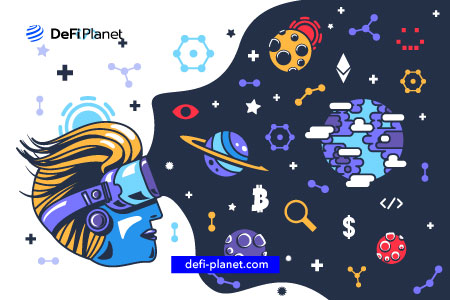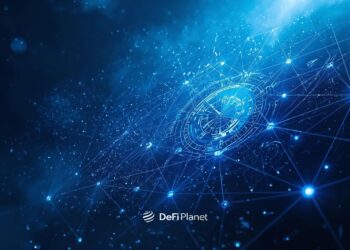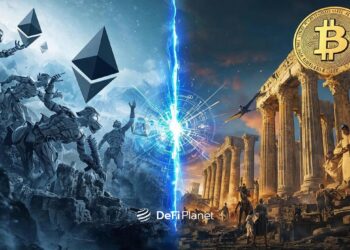There are numerous blockchains in the blockchain space, each with its own set of features. Some are designed specifically to solve the blockchain trilemma, particularly the scalability challenges that older chains such as Ethereum are confronting. Some networks were created to enable developers to create decentralized apps that are compatible with other blockchains.
The Cosmos network is a decentralized network of independent, scalable, and interoperable blockchains, created with the vision of solving the current challenges of blockchain scalability. The Cosmos network is designed to function as a blockchain with features that allow developers to create networks without having to code from scratch.
This article explores the Cosmos network in detail, its core elements, and what it has to offer the blockchain community.
Cosmos: A short origin story
Jae Kwon created Tendermint, the inspiration for Cosmos, in 2014, before the network was established. In 2015, he decided to collaborate with Ethan Buchman to redesign the architecture of Tendermint.
Cosmos was founded in 2016 by Ethan Buchman and Jae Kwon, who also wrote the whitepaper.
The Cosmos Network is affiliated with the Interchain Foundation (ICF), a non-profit organization based in Switzerland that is responsible for numerous open-source blockchain technologies. It is the driving force behind the development and funding of the Cosmos Network. It held funding rounds for Cosmos development in 2019.
The Tendermint Core team is responsible for developing and adding functionality to the Cosmos Network. They are in charge of the Cosmos Hub’s development.
According to Peng Zhong, Tendermint’s first employee, and current CEO, “There is a lot of potential in blockchain to reshape collaboration and connectivity and decision making across the world, and we’ve seen a lot of examples of this with the chains that are IBC enabled right now. We see a future where there will be hundreds, thousands, tens of thousands and a million blockchains further in the future, and that’s what we’re building towards.”
What is Cosmos?
Cosmos is envisioned as the internet of blockchains, according to its creators. It differs from other chains in that developers are only allowed to create decentralized apps on the network, such as DeFi platforms and NFT ecosystems.
In this case, development teams are free to design their chains with the functionalities they desire rather than having to build them from scratch. One of the reasons it is so popular is the plethora of open source tools it provides.
Cosmos ticks the customization box for developers since they can create their platforms to include any feature they wish. Aside from the abovementioned, the network is also interoperable with other chains, eroding the isolation feature.
Cosmos is very decentralized as it allows different developers to build unique networks that communicate with one another. Every chain built on Cosmos is referred to as a “Zone.” Zones can interact with one another and share data as needed.
The Cosmos ecosystem consists of various components that can interact seamlessly with each other through several layers:
- Staking layer: Consisting of Tendermint Core and other compatible software
- Blockchain layer: Consisting of staked PoS chains that run on top of Tendermint Core or other compatible software
- Application layer: including wallets, block explorers and dApps
What is Cosmos Network’s native token?
ATOM, Cosmos Network’s native token, serves as the ecosystem’s underlying key, allowing users to access the various features that the blockchain provides.
According to CoinMarketCap, ATOM is currently ranked 24th in terms of market capitalization.
In the Cosmos Network, ATOM has several use cases, some of which will be explained further below.
• Voting mechanism
Cosmos’ governance mechanism is decentralized, which means that those who own and stake the native token, ATOM, can vote on prospective changes and submit proposals. The Cosmos Hub validators will have the right to vote on proposals submitted by other users. The ATOM staking mechanism, which is a crucial part of this process, allows validators to vote and earn rewards based on the number of tokens they are staking.
Validators can use their votes in two ways: they can either approve or disapprove of a proposal. If at least 51% of all token holders vote “yes” for a proposal, then it will be considered approved. If there is a disagreement between different groups, then the Cosmos Hub protocol will automatically execute an upgrade and distribute these new versions accordingly to all participants within its network. Before major decisions are made, a voting session is announced, and users can vote based on the number of tokens they own and stake.
• Network Consensus
ATOM is required for network consensus. Before Validators can validate transactions or produce new blocks, they must first bind some tokens to the network.
This reduces the possibility of the validator collaborating or acting as a bad player in the ecosystem. Validators are compensated for their contributions to the network, as they are critical to its sustainability.
• Reducing spam
Gas fees are considered an important measure for curbing spam incidents. This is because crypto users may be discouraged from carrying out spam attacks if they consider the fees that they must pay when initiating a transaction.
Spam attacks have previously disrupted the operations of networks such as Nano, which do not charge gas fees.
In March 2021, Nano, a network that uses DAG (Directed Acyclic Graph) to settle transactions, was hit by spamming attacks that grounded it to a halt, preventing users from taking advantage of its capabilities. Unlike traditional cryptocurrencies, Nano does not use blockchain; instead, it uses DAG.
It takes pride in providing free transactions with no costs, and problems with this arose in March 2021.
• Staking rewards
Token holders can stake them to validators and earn rewards for doing so. Staking is a passive source of income for delegators, and the rewards earned are determined by the agreement reached with validator nodes as well as the activities of the nodes chosen.
Elements of the Cosmos Network architecture
The Cosmos Network has different features that work together to make it easy for developers to build their independent chains within the ecosystem while also allowing the network to operate smoothly.
Cosmos Hub
The Cosmos Hub is the heart of the Cosmos network, and it is an interoperable blockchain platform that connects to the various blockchains (zones) being constructed by independent developers in Cosmos.
The Cosmos Hub must record the transactions and state of each zone or independent blockchain on the network. As the hub of the ecosystem, it is in charge of the network’s Proof-of-Stake consensus mechanism.
As the first blockchain established on the Cosmos network, it ensures that each zone operates efficiently, hence enhancing interoperability.
Though Cosmos keeps a record of the state of each zone, this does not affect the independence of the different zones in the network. Every blockchain can be customized to the needs of the developers, allowing them to create their native tokens, distribute them as they deem fit, verify transactions, and much more. Zone developers do not need the permission of Cosmos Hub or the team to make changes to their independent chains.
Cosmos SDK
The Cosmos SDK is a development toolkit that developers can use to create blockchains on the network. As a software development kit, it simplifies the process of creating a chain rather than beginning from scratch. The SDK enables developers to design their bespoke architecture based on the Tendermint consensus algorithm.
Developers have access to functionalities in the kit that make developing common features easy.
The SDK is written in Go, an open-source programming language that was created at Google and released in 2009. This language is based on C++ and has been used by Google since 2007. It has become popular because of its simplicity; it does not require advanced knowledge of computer science or mathematics for people to learn how to use the language effectively.
Cosmos Zone
Cosmos Zones are independent blockchains created by developers on the Cosmos Network. Zones are developed using the Cosmos SDK. This makes it easy for developers to build custom blockchain projects on top of this infrastructure.
The Inter-Blockchain Communication (IBC) protocol allows Cosmos Zones to communicate with other zones and with other blockchains through the Cosmos Hub. The Tendermint BFT consensus algorithm secures both public and private transactions within each zone. It’s built with the Cosmos SDK, which makes it easy for developers to create their blockchain projects on top of this infrastructure.
The IBC (Inter-Blockchain Communication) protocol allows Cosmos Zones to communicate with other zones and with other blockchains through the Cosmos Hub. The Tendermint BFT consensus algorithm secures both public and private transactions within each zone.
Zones are autonomous, but they can exchange data and interact with one another to ensure interoperability.
Inter-Blockchain Communication Protocol (IBC)
Independent blockchains or Zones are linked to the Cosmos Hub through the IBC, allowing different parties to interact with one another in a safe environment. The Inter-Blockchain Communication (IBC) Protocol is the primary protocol used by Cosmos to transfer tokens between blockchains. It is an open standard that ensures interoperability between blockchains.
The IBC protocol employs a request/response protocol to transfer tokens between chains and operates at the application layer, similar to how TCP/IP operates on the internet. This protocol also acts as the link between a zone and another, ensuring interoperability.
Tendermint Byzantine Fault Tolerance (BFT)
In this section, we’ll go into more detail about the Tendermint BFT protocol and its implementation in Tendermint Core. Tendermint Byzantine Fault Tolerance (BFT) is an algorithm critical to the Cosmos architecture’s operation, allowing validator nodes to seamlessly verify transactions and create new blocks.
The Byzantine Fault Tolerance (BFT) consensus algorithm is a general-purpose consensus algorithm that allows for Byzantine faults to occur during its execution. A fault is any deviation from the normal expected behaviour of an entity with respect to its operation or processing of information. The main objective of BFT is to ensure that each node in the system can reach an agreement on which block has been added last, instead of reaching an agreement on all blocks at once, which would be impossible with faulty nodes.
Tendermint Core is the first implementation of the Tendermint consensus engine, which provides an innovative approach towards achieving consensus using Proof-of-Stake (PoS) as well as other mechanisms such as leader election and Kemono leadership election based on virtual voting rights by account holders who hold Tendermint (TM) tokens within their account balances; it also supports different types of rewards based on staking and voting activity (e.g., PoS reward), reputation management, and economic incentives via fees paid by users who want access rights over secure data stored within blockchain ledgers without necessarily owning any TM tokens themselves (e.g., read-only access rights).
In the Cosmos Network, validators are selected from the top one hundred nodes with the most staked ATOM. To become a validator, the user can either stake their tokens and hope that the quantity they stake puts them in the top 100, or they can acquire tokens from other stakers or ordinary holders. Delegating one’s tokens to the validator typically results in a portion of the block reward being earned by the selected validator.
In Conclusion,
- The Cosmos Network is an internet of blockchains.
- It allows developers to create their independent chains or zones, incorporating any features they desire.
- Developers can utilize the Cosmos Development Kit to easily create their chains and add plugins for customization if desired.
- The Cosmos Zones are linked to one another as well as the Cosmos Hub via the Inter-Blockchain Communication Protocol (IBC) protocol.
If you would like to read more articles like this, visit DeFi Planet and follow us on Twitter, LinkedIn, Facebook, and Instagram.
“Take control of your crypto portfolio with MARKETS PRO, DeFi Planet’s suite of analytics tools”





















